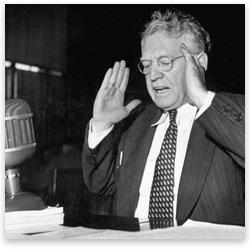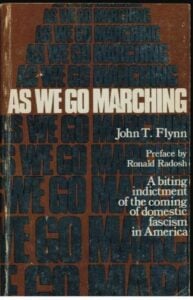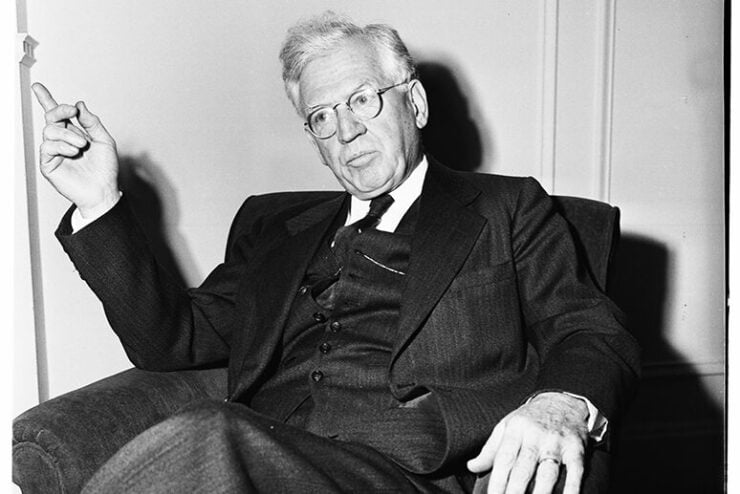Icon of the Old Right
He has been labeled an “exemplar of the Old Right,” a “prophet,” a “master polemicist,” a “passionate spokesman for the extreme Right Wing,” a “muckraking investigative journalist,” and later, by a U.S. president he once supported, a “destructive rather than a constructive force,” who should be “barred” from further writing. Though once characterized as a “New Deal liberal” who wrote for The New Republic, John T. Flynn eventually became an icon of the Old Right.
Born in Maryland in 1882, John Thomas Flynn was raised and educated as an ardent Catholic. He originally studied law at Georgetown but soon moved into the field of journalism, specializing in finance and economics. He got his first job with the New York Globe, writing on fraud in the markets and his belief that the government had a role to play in the economy, acting more like a referee than a participant, making sure the playing field was fair and honest while competition was maintained. Flynn believed that government could function in such a manner because it represented all people, not just a chosen few. For Flynn, at least in this early stage of his life, it was Wall Street and the investment trusts that were the real enemy.
In addition to writing for the Globe, Flynn wrote pieces for Collier’s Weekly and Harper’s Magazine, two famous muckraking publications, and began to write books as well. His early financial volumes included Investment Trusts Gone Wrong!, Graft in Business, and a biography of John D. Rockefeller called God’s Gold.
When the Great Depression hit in 1929, President Herbert Hoover, in contrast to his predecessors Harding and Coolidge, used the government to fight the downturn, raising tariffs and taxes, and creating new programs like the Reconstruction Finance Corporation. But Flynn attacked that entity, writing that it was
borrowing money from the banks and appropriating to other government bureaus. Of course this practice brings to an end the ‘power of the purse’ by which parliaments in free democracies control executives. And so you find these bureaus supplying one another with money as part of this new system of eliminating Congress from its historic role of controlling the purse strings.
In 1932, Flynn supported Franklin Delano Roosevelt enthusiastically and soon began a weekly column, for The New Republic, called “Other People’s Money.” Early on, he supported what Roosevelt was doing, especially his call for a national bank holiday. The government should look into banking practices and how securities were manipulated, he believed, in order to clean up and reform the worst aspects of capitalism—elimination of excess profits with a federal income tax specifically on those profits and a tax on employers to finance a social security system as well. Then, he wrote, the administration should craft “a plan … to produce income by producing work; to produce work by launching great public and private construction enterprises that will yield wages to those on jobs and in the material factories.”
But it didn’t take Flynn long to become disillusioned. FDR had attacked Hoover as having presided over the “greatest spending administration in peace times in all our history.” But then, after the famed 100 Days, Roosevelt had accumulated a larger deficit than Hoover had amassed in two years! The government should not rely on borrowing for funds, Flynn believed, but on new tax receipts.
Flynn also believed that one of the worst aspects of the New Deal was the National Recovery Administration. The NRA was “one of the most amazing spectacles of our times,” he wrote, one “that represented probably the gravest attack upon the whole principle of the democratic society in our political history.” His main complaint was that the trade associations would set prices, wages, hours, and production quotas, thereby placing the country on the road to a kind of guild fascism.

his radio show, date unknown
(Mises Institute)
“I say this New Deal is fake,” Flynn stated in a radio address in December 1933.
It has been sold to our people as a great liberal revolution. That is a fraud. It is nothing else than the scheme which the Chamber of Commerce of the United States has been fighting for twelve years—the modification of the Sherman anti-trust law and turning over the control of industry to the tender mercy of the trade associations. Employers are compelled to combine. But laborers are not.
Flynn later penned a book, The Road Ahead, that portrayed the New Deal as the first step to tyranny.
In a 1940 book critical of FDR, Country Squire in the White House, Flynn lambasted the president for following a path already traveled by fascists in Europe:
While at the same time proclaiming his devotion to democracy, [FDR] adopted a plan borrowed from the corporative state of Italy and sold it to all the liberals as a great liberal revolutionary triumph. And, curiously, every American liberal who had fought monopoly, who had demanded the enforcement of the anti-trust laws, who had denied the right of organized business groups, combinations and trade associations to rule our economic life, was branded as a Tory and a reactionary if he continued to believe these things.
In Flynn’s view, Roosevelt had adopted a corporatist policy that served the desires of the corporate world. And he had spent tons of money on it, but it was not working. As the depression dragged on, Flynn accurately predicted Roosevelt’s next move: using war, or what Flynn called the war scare, to move the country forward. As the late anti-war author Justin Raimondo wrote, “World War II would be the ultimate New Deal jobs program.”
War promotion would also help Roosevelt with conservatives in Congress, who were antagonistic to the New Deal and suspicious of centralization in general but who would support national defense spending and preparation for war. “If conservative objectors to deficits do not like WPA,” Flynn wrote in his New Republic column in 1939, “very well, [FDR] will give them what they like—battle ships, armies. He will create an industry for them: the armament industry.” And this is where Flynn really made his mark and became an icon for the Old Right: foreign affairs and the newly formed welfare-warfare state.

Writing in one of his greatest works, As We Go Marching, Flynn not only exposed what Roosevelt was up to but also described the current American state with regard to corporatism and militarism:
[These] two stubborn forces will always force a government like ours to find a project for spending which meets these two conditions: It must be a strictly federal project and it must be one upon which the conservative and taxpaying elements will be willing to see money spent. The one great federal project which meets these requirements is the army and navy for national defense.
To accomplish this military-industrial arrangement, the president would have to whip up hysteria. In The New Republic, Flynn accused FDR of “deliberately selling to our people the baleful notion that some enemy is about to assail us.” Early incidents like the sinking of the Panay in 1937 would be used to incite emotion among the people, who would then willingly support an arms buildup. This would “thrust forward into the solution to our domestic problems foreign quarrels with which we should have nothing to do,” Flynn wrote to Senator William Borah. Nevertheless, FDR’s plan worked. As historian Ronald Radosh has written, “The once-hated New Deal was now backed by business-minded conservatives who saw an answer to their problems in war production.”
“I dare say no one can stop it,” Flynn noted of the new war production policy. “The Democrats have come around for it, and the Republicans have always been for it. The liberals favor it, the radicals favor it. Business favors it; the idealists favor it. Hence we shall have it.” But Flynn did not take matters lying down. He helped form the America First Committee and served as chairman of the New York City chapter.
Such activities, though, came at a price, as The New Republic dropped his column, while Roosevelt himself assailed Flynn in a private letter to the editor of the Yale Review. Others in Flynn’s camp, like Garet Garrett and Oswald Garrison Villard, were similarly blacklisted. Flynn wrote about the threats he and others faced—even from J. Edgar Hoover’s FBI—in The Smear Terror.
When war finally came with the Japanese attack on Pearl Harbor, Flynn didn’t join the War Party. Far from it. He continued to assault Roosevelt in two small booklets, The Truth About Pearl Harbor and The Final Secret of Pearl Harbor, in which he alleged that the United States provoked the Japanese into an attack. And in 1948, he penned a full analysis of FDR, The Roosevelt Myth.
The war certainly seemed to complete Flynn’s transformation to the Old Right. As Murray Rothbard wrote in his book, The Betrayal of the American Right, “The drive of the New Deal toward war once again reshuffled the ideological spectrum and the meaning of Left and Right in American politics.” Many who had started as liberals, like Flynn, moved rightward, especially, as Rothbard put it, “under the hammer blows of the Left-liberal establishment,” a process by which “the forging of the ‘Old Right’ was completed.”
Flynn was truly a political prophet, as Radosh called him, forecasting the future for the United States. And his predictions were chillingly accurate. During the Cold War, Flynn stated that it was not necessary to go to war against global communism because all America had to do was “sit tight and put their faith in the immutable laws of human nature.” In other words, the U.S. needed to “make an end of the cold war” because communism would one day fall on its own.
Of course, the warfare state was much too powerful during the Cold War to simply work toward an absence of conflict. There was fighting on the Korea Peninsula in the early 1950s, just five years after the end of World War II. And soon after that “police action” had concluded, Flynn predicted the next American war: French Indochina, as “an American military mission is … on its way to that country.” He warned his radio audience, “if we are preparing to make war to save Asia from dictatorships we will waste every dollar, every pound of steel and every precious life that is snuffed out in that foolish adventure.”
Fighting communism was a “waste of time,” he wrote in As We Go Marching (1944), because the real threat was fascism at home, which would indeed come to America, he predicted in a frighteningly accurate vision, at the hands of perfectly authentic Americans
who are convinced that the present economic system is washed up … and who wish to commit this country to the rule of the bureaucratic state; interfering in the affairs of the states and cities; taking part in the management of industry and finance and agriculture; assuming the role of great national banker and investor, borrowing billions every year and spending them on all sorts of projects through which such a government can paralyze opposition and command public support; marshalling great armies and navies at crushing costs to support the industry of war and preparation for war which will become our greatest industry; and adding to all this the most romantic adventures in global planning, regeneration, and domination, all to be done under the authority of a powerfully centralized government in which the executive will hold in effect all the powers, with Congress reduced to the role of a debating society. There is your fascist. And the sooner America realizes this dreadful fact the sooner it will arm itself to make an end of American fascism masquerading under the guise of the champion of democracy.
In 1960 John T. Flynn called it quits, laying down his pen and retiring from public life, as his health began to slip. After an illness, he died in 1964 at the age of 81. Though his work has largely been forgotten, erased by the establishment powers he opposed, his legacy as an icon of the Old Right should be secure forever.

Leave a Reply